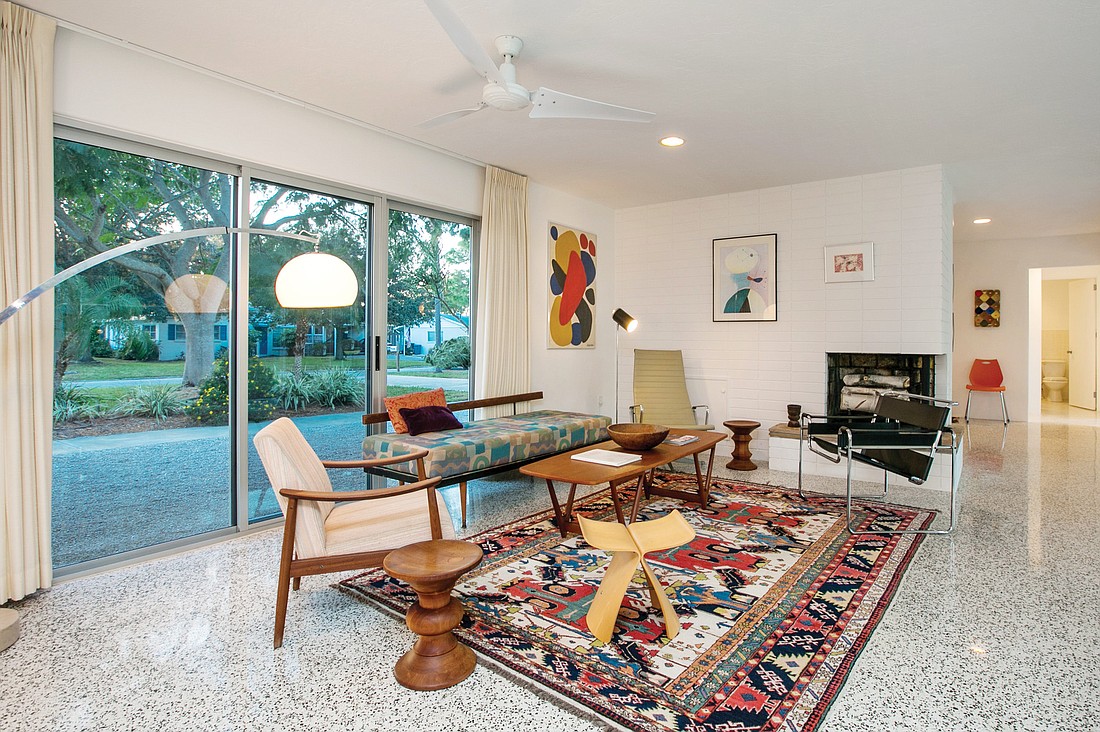- November 27, 2024
-
-
Loading

Loading

Many houses have character: It can come from a great design or from years of happily accommodating family life, with all its ups and downs. But, a house that has personality — that extra spark of life that you can sense the moment you walk in — that’s much harder to find.
This modest-looking ranch/bungalow in the sleepy neighborhood of Pine Shores is a case-in-point. During a recent open house, when the home came on the market for the first time in almost 50 years, you could feel the buzz in the air. The people who dropped by were amazed by what they were seeing.
On one hand, it was a simple, modest home. But, with its furniture and art — plus a sensitive redesign by architect Jack West — there was an artistic sensibility at every turn, not to mention a delightful history lesson in American art dating back to the 1950s.
The story begins when Glenn and Genevieve Hannan, a couple from Detroit, moved to Florida, first to Englewood, then, in 1969, to Sarasota, where they bought the bungalow on Wildwood Street. Glenn Hannan was a woodshop teacher and Genevieve Hannan a homemaker.
“They were very sensitive aesthetically,” recalls their great-niece Pam Sharp. “But they weren’t educated as artists.”
But, their son, Tom, certainly was. A graduate of Wayne State, Tom Hannan, like many ambitious young creative people of the time, moved to New York City. His talent got him a scholarship to the legendary Hans Hofman School of Fine Arts, where he worked and studied with many of the leaders of the Abstract Expressionism movement. Soon Tom Hannan was in the middle of the burst of creative energy that made New York City the world capital of painting and sculpture.
In 1954, Tom Hannan married Allison Smith, a New York girl who had studied fashion design at Parsons. The two of them settled into a cold-water flat in what is today the heart of SoHo. To supplement his income, Tom Hannan began designing record album covers for the great jazz artists of the time, particularly the masters of “bebop,” the strident, almost aggressive form of improvisation that morphed into what is today known as modern jazz. In that heady time of “beatniks” and artistic experimentation, Sharp recalls that “it wasn’t unusual for the two of them to ‘close out Mingus’ in the wee hours of the morning at the Five Spot on the Bowery.”
As Tom Hannan’s career progressed, the couple settled in Guilford, Vt., where Tom Hannan painted in a barn on the property. They began spending more time in Florida with Tom Hannan’s mother (Glenn Hannan died in the early 1990s.) But, it wasn’t until 2000, when both Tom and Genevieve Hannan died, that Allison Hannan called architect Jack West. She was getting older and wanted a walk-in shower. With the way such things often go, she soon had a much bigger house.
West incorporated the lanai along the back of the house into the living area, thus creating a large open space that suggests, appropriately enough, a SoHo loft. With art-gallery-white walls, it became the perfect setting for the Hannans’ collection of modernist furniture and their art, both Tom Hannan’s work and other artists of the period. The furniture includes a pair of Ludwig Mies van der Rohe Barcelona chairs, a Knoll sofa and coffee table and some whimsical stools by Charles and Ray Eames. West also placed a large Jack Cartlidge sculpture in front of the house, a signature touch of his.
To accommodate Allison Hannan’s plans for aging-in-place, he built a new master bathroom with a walk-in shower and leveled the floors through the home. The kitchen was left pretty much untouched; it still retains the original 1950s wall oven.
The house got a burst of fresh artistic energy when Pam and her husband, Willoughby Sharp, began visiting more frequently. Willoughby Sharp, who died in 2008, was a prominent member of the next generation of New York artists, when the style switched over to conceptual and performance art. His pieces were designed to shock, often producing what the New York Times described as a “mixture of horror and awe.” One of his most famous, “Full Womb,” in 1975, consisted of Willoughby Sharp climbing into an industrial-sized clothes dryer clutching a baby bottle and then tumbling for 15 minutes while he imagined his parents making love.
There is no information as to whether Willoughby Sharp actually climbed into the dryer at the Hannan home, but he did produce a particular Sarasota art piece for the living room. On a visit to the Woman’s Exchange in 2006, he spied a modernistic white ceramic vase.
“Like a bird dog he wound his way through the furniture to grab it,” Pam Sharp recalls.
Later that afternoon, he found a purple beach ball at Publix to top it off. The result? “Transmitter 5849,” which Pam describes as “an expression of Willoughby’s eternal transmission of art force.”
Allison Hannan has decided to stay in Vermont permanently, and, so, the home was recently put on the market. According to Realtor Martie Lieberman, who handled the listing, it sold immediately, with six different offers.
Pam Sharp is busy packing up the art — the Jack Cartlidge sculpture will stay — and then she will return to her home in Brooklyn, N.Y., to prepare for an exhibit of paintings from the Hannans’ art collection, which will open Feb. 15, at Betty Krulik Fine Arts Ltd., 15 East 71 St., in Manhattan. The collection contains not just Tom Hannan’s work, but also pieces by members of his and Allison’s circle of friends from the old days, including Al Held and Jan Muller.
And as for the furniture? The new owners are purchasing it, too. Thus, though the house may be changing hands, the artistic spirit it represents — not to mention the lively personality — will be intact for years to come.